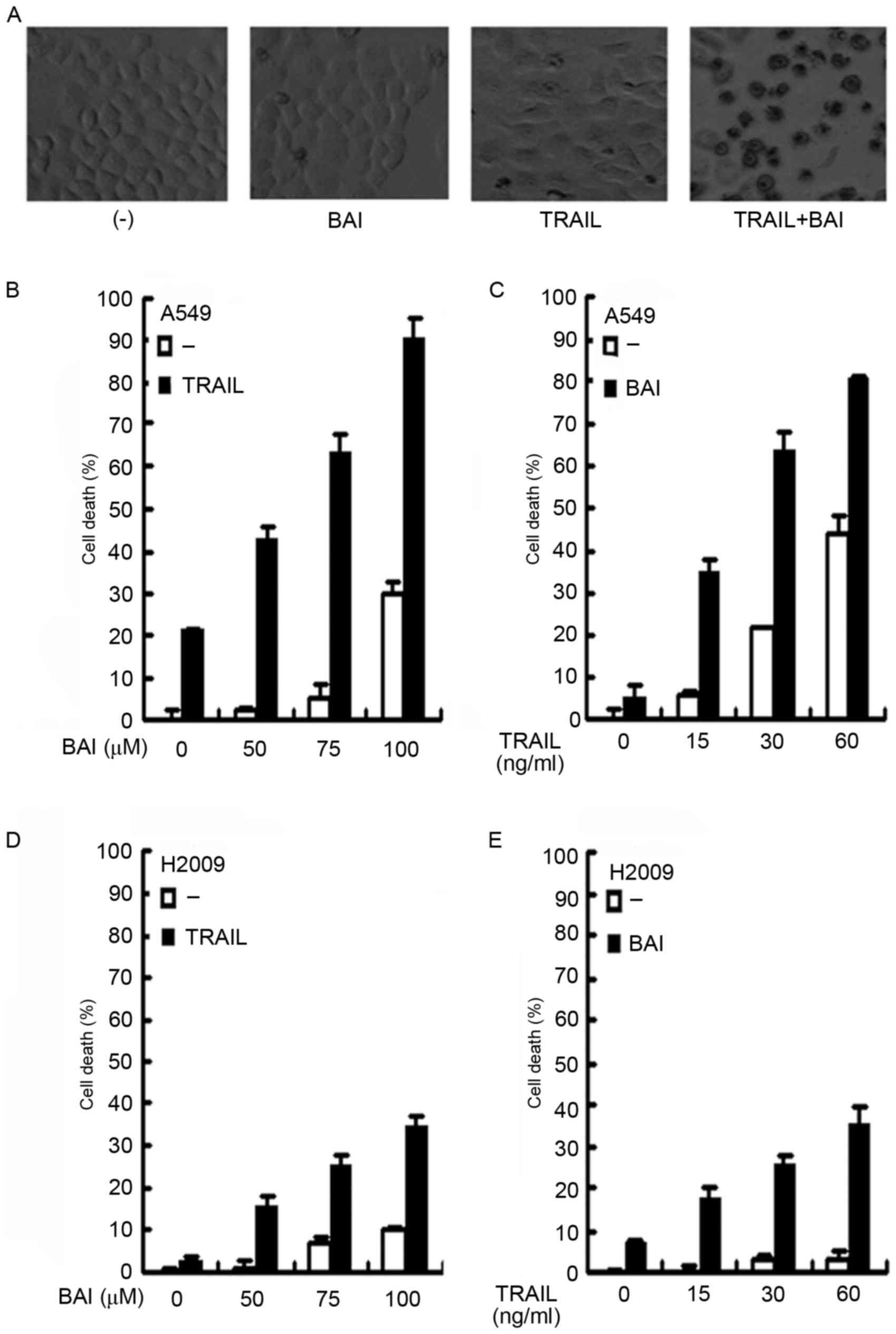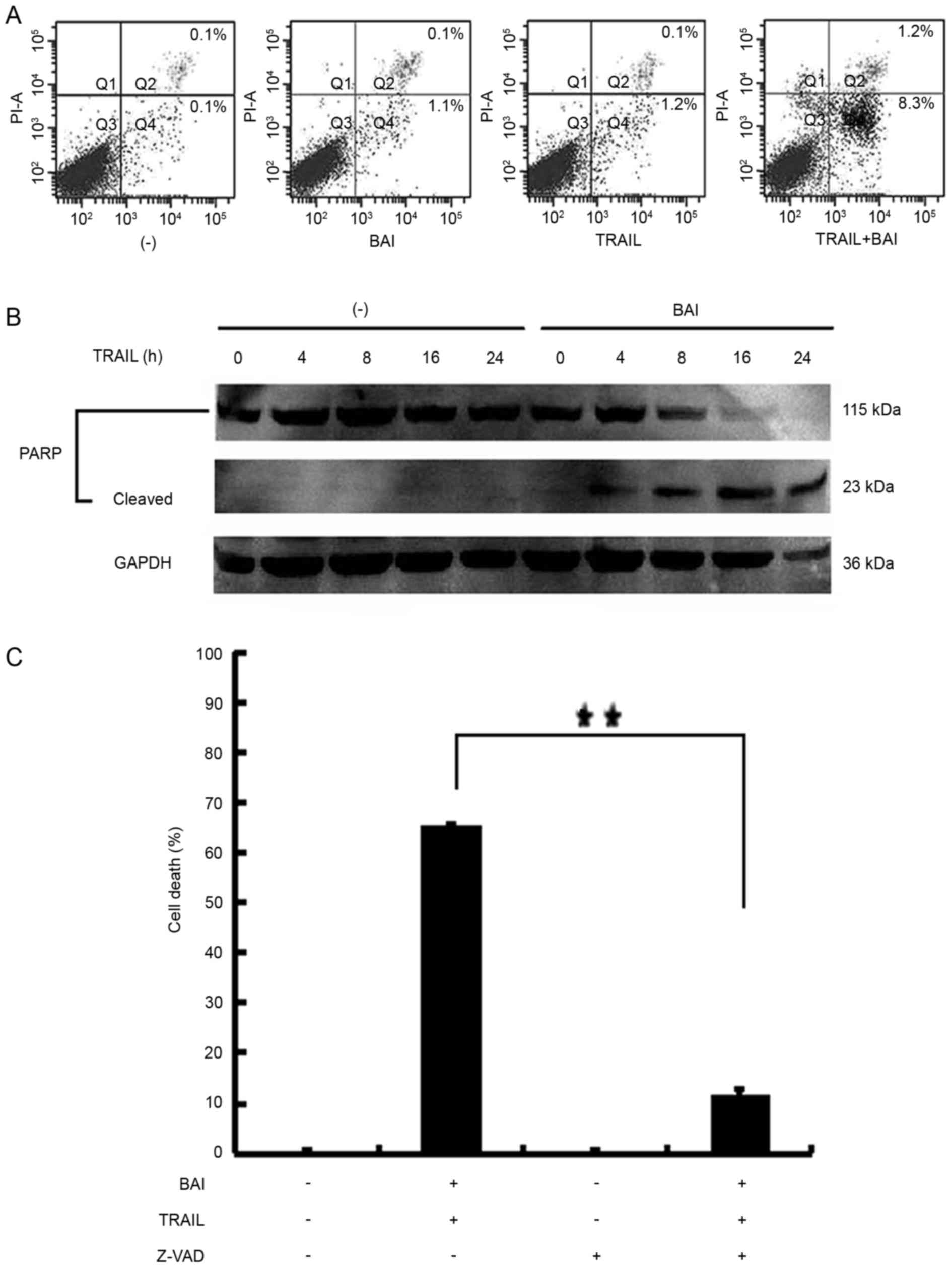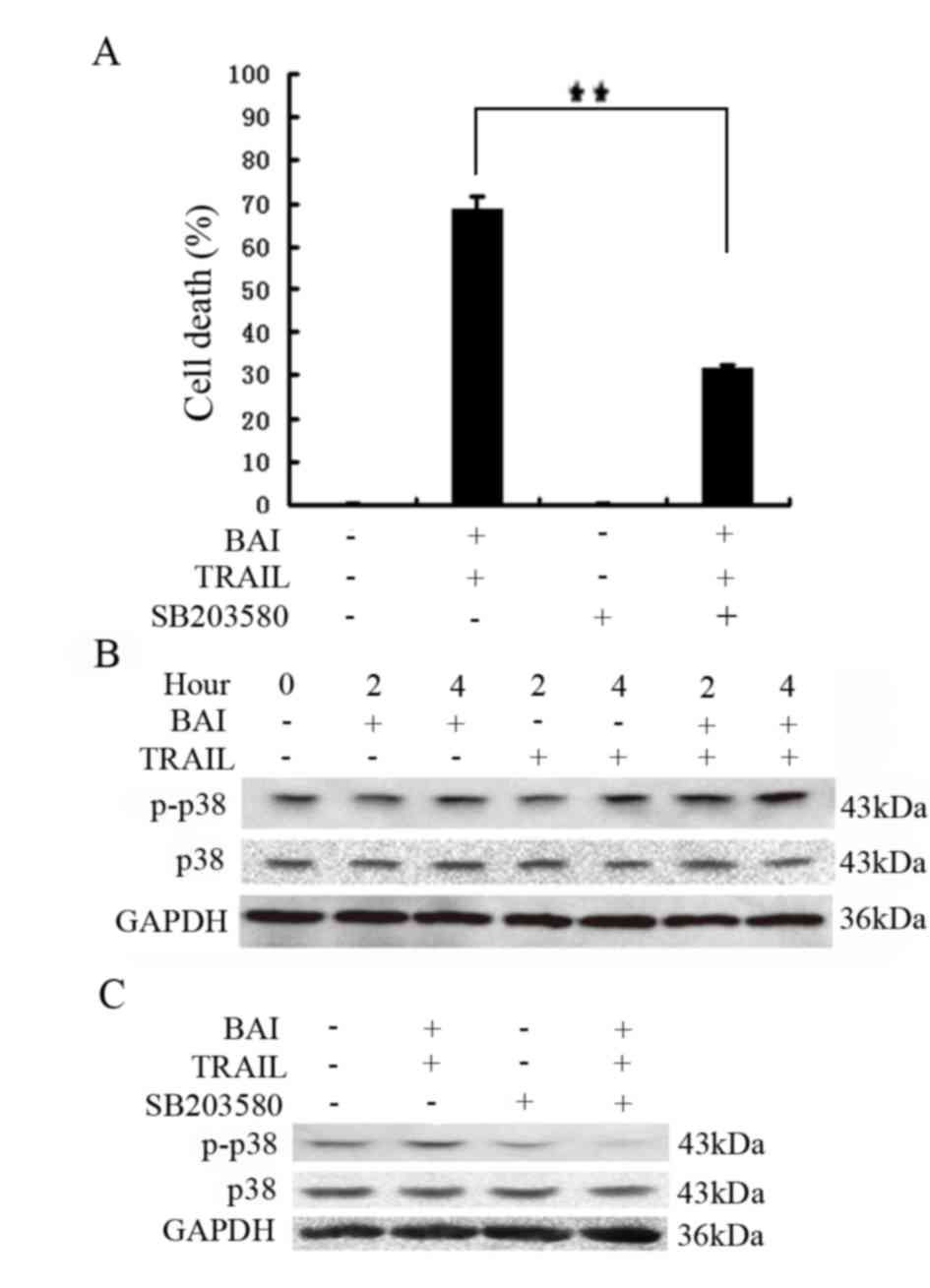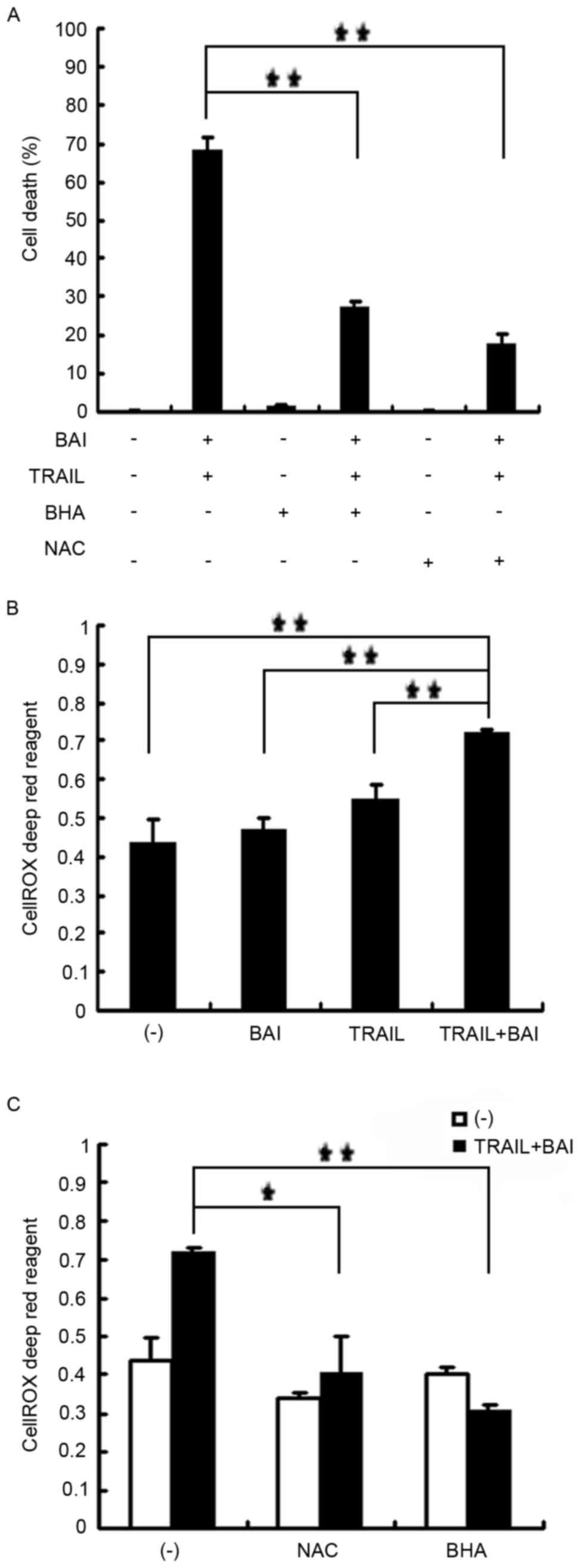Baicalin potentiates TRAIL‑induced apoptosis through p38 MAPK activation and intracellular reactive oxygen species production
- Authors:
- Published online on: September 26, 2017 https://doi.org/10.3892/mmr.2017.7633
- Pages: 8549-8555
Abstract
Introduction
Tumor necrosis factor (TNF)-related apoptosis-inducing ligand (TRAIL) is a potential anticancer agent. Numerous cancer cells have exhibited sensitivity to TRAIL-induced death, which has not been observed in normal cells. TRAIL binds to at least five receptors, including death receptors 4 and 5, which are functional TRAIL receptors. However, decoy receptors 1 and 2, and osteoprotegerin are decoy TRAIL receptors that inhibit the death-inducing activity of TRAIL (1). The application of TRAIL in cancer therapy is hindered due to TRAIL-associated resistance in cancer cells. The mechanisms of resistance may be associated with the dysfunction of TRAIL-induced signaling and/or high expression levels of anti-apoptotic molecules. TRAIL activates several cellular signaling pathways, including those involving mitogen-activated protein kinases (MAPKs), which result in apoptosis (2–4). Combining TRAIL with other agents to modulate these molecules or pathways may help to overcome TRAIL-associated resistance and therefore improve the therapeutic applications of TRAIL (2,3).
Scutellaria baicalensis Georgi is a common Chinese medicinal herb, which contains various flavonoids, including baicalin, wogonin, wogonoside, oroxylin A and oroxylin A-7 (5). These flavonoids have various activities. Baicalin (5, 6-dihydroxy-7-o-glucuronide flavone) has been reported to possess a diverse range of pharmacological properties, including antioxidant, anti-inflammatory, antiviral and anticancer activities (6). Human leukemia, myeloma, breast, lung, bladder and lymphoma cancer cells were potently suppressed by this flavone as reported in previous studies (7–9). The molecular mechanisms underlying these effects are thought to involve alterations in oxidation/reduction status, cell cycle inhibition and the induction of apoptosis (6). However, the effect of baicalin on the anticancer activity of TRAIL has yet to be explored.
In the present study, non-small cell lung cancer cell lines A549 and H2009 were treated with the combination of baicalin and TRAIL. Baicalin potently sensitized TRAIL-induced apoptosis of cancer cells via p38 MAPK activation and induction of intracellular reactive oxygen species (ROS) accumulation.
Materials and methods
Reagents
Glutathione S-transferase-TRAIL was purchased from SinoBio Biotech Ltd., (Shanghai, China). Baicalin was purchased from the National Institute of the Control Pharmaceutical and Biological Products (Beijing, China). Z-VAD-FMK was obtained from Calbiochem (EMD Millipore, Billerica, MA, USA). Butylated hydroxyanisole (BHA) and N-acetyl-L-cysteine (NAC) were purchased from Sigma-Aldrich (Merck KGaA, Darmstadt, Germany). 4-(4-fluo-rophenyl)-2-(4-methylsulfinylphenyl)-5-(4-pyridyl)-imidazole (SB203580) (cat. no. 152121-47-6) was obtained from Gene Operation (Ann Arbor, MI, USA). The JNK inhibitor SP600125 (cat. no. 129-56-6) was from EMD Millipore. The ERK inhibitor U0126 (cat. no. #9903) was from Cell Signaling Technology Inc., (Danvers, MA, USA). CellROX Deep Red reagent was purchased from Thermo Fisher Scientific, Inc., (Waltham, MA, USA). The antibody poly (ADP-ribose) polymerase (PARP; cat. no. AP102) was obtained from Beyotime Institute of Biotechnology, Haimen, China). Anti-p38 MAPK (cat. no. #9212) and anti-phosphorylated-p38 MAPK (Thr180/Tyr182) antibodies (cat. no. #9211) were purchased from Cell Signaling Technology Inc., (Danvers, MA, USA). All of the above antibodies were diluted 1:1,000 in 5% milk. Anti-GAPDH antibody (1:2,000; cat. no. 10494-1-AP) was obtained from Proteintech Group, Inc. (Chicago, IL, USA).
Cell culture
Two non-small cell lung cancer cell lines A549 and H2009 were from the American Type Culture Collection (ATCC, Manassas, VA, USA) and cultured in RPMI 1640 medium (cat. no. SH30809.01; Hyclone; GE Healthcare Life Sciences, Logan, UT, USA) supplemented with 10% fetal bovine serum (Hyclone; GE Healthcare Life Sciences), 1 mmol/l glutamate, 100 U/ml penicillin and 100 µg/ml streptomycin under standard incubator conditions at 37°C with 5% CO2.
Cell death assay
Cells were seeded in a 96-well plate 24 h prior to treatment and were then treated with baicalin, TRAIL alone or in combination for 72 h. Then culture medium from each well was collected and transferred to 96-well flat-bottomed plates. Lactate dehydrogenase (LDH) activity was determined by adding equal volumes of the reaction mixture to each well and incubating for 30 min at 22°C. The absorbance of the samples was measured at 490 nm using a plate reader (Tecan Infinite F200). Cell death was detected quantitatively via lactate dehydrogenase (LDH) release using a cytotoxicity detection kit (Promega Corporation, Madison, WI, USA) as described previously (10). All experiments were repeated three to five times; the average is presented in each figure. Cell death was calculated using the formula: Cytotoxicity (%) = (experimental value-spontaneous LDH release) / (maximum LDH release - spontaneous LDH release) × 100%.
Analysis of apoptosis by flow cytometry
Apoptosis was detected by flow cytometry. A549 cells were seeded into a 6-well plate 24 h prior to treatment and were then treated with baicalin (75 µM), TRAIL (30 ng/ml) alone or in combination for 48 h. Subsequently, the cells were double stained with Annexin V-fluorescein isothiocyanate (V-FITC) and propidium iodide (PI) using an Annexin V-FITC Apoptosis Detection kit (Nanjing KeyGen Biotech Co., Ltd., Nanjing, China) according to the manufacturer's protocol. Early apoptosis is defined by Annexin V+/PI− staining (Q4) and late apoptosis is defined by Annexin V+/PI+ staining (Q2,) as determined by fluorescence-activated cell sorting (Beckman Coulter, Inc., Brea, CA, USA).
Western blot analysis
A549 cells were seeded in a 6-well plate 24 h prior to treatment and were then treated with baicalin (75 µM), TRAIL (30 ng/ml) alone or in combination for 72 h. Cell extracts were then prepared by lysing cells in M2 buffer [20 mmol/l Tris-HCL (pH 7.6), 0.5% NP-40, 250 mmol/l NaCl, 3 mmol/l EDTA, 3 mmol/l EGTA, 2 mmol/l dithiothreitol, 0.5 mmol/l phenylmethylsulfonyl fluoride, 20 mmol/l β-glycerophosphate, 1 mmol/l sodium vanadate and 1 µg/ml leupeptin] and homogenizing them on ice. The extracts were subsequently incubated on ice for 30 min. Protein concentration was determined using a Bradford protein assay kit (Beyotime Institute of Biotechnology, Haimen, China) according to the manufacturer's protocol. Protein samples (50 µg) were separated by 10% SDS-PAGE. The proteins were transferred to a nitrocellulose filter membrane (Bio-Rad Laboratories, Inc., Hercules, CA, USA) following separation. The membrane was blocked with 5% bovine serum albumin (Sigma-Aldrich; Merck KGaA) in 1X Tris-buffered saline and 0.05% Tween-20 (TBST) for 1 h at room temperature with agitation. The membrane was then incubated with primary antibodies (1:1,000) at 4°C overnight, after which the membrane was washed three or five times with 1X TBST and was then incubated with the horse radish peroxidase-conjugated goat anti-rabbit immunoglobulin G (cat. no. ZB 2301; 1:2,000; OriGene Technologies, Inc., Rockville, MD, USA) for 1 h at room temperature with agitation. The proteins were visualized by enhanced chemiluminescence (Merck KGaA) using Bio-Rad Image Station (Bio-Rad Laboratories Inc.). Each experiment was repeated at least three times and representative results are shown in each figure.
Detection of ROS
Cells were cultured in 12-well plates overnight and subsequently treated with baicalin (75 µM), TRAIL (30 ng/ml) alone or in combination for 3 h. Cells were then stained for 30 min with 5 µM CellROX Deep Red reagent (Thermo Fisher Scientific, Inc.), washed three times with precooled PBS, and analyzed using a Multiscan Spectrum plate reader (Thermo Fisher Scientific, Inc.). The wavelengths were set as follows: Excitation, 640 nm; emission, 665 nm. All the experiments were repeated at least three times, and representative results are shown in each figure (11,12).
Statistical analysis
The presented data and results were confirmed in at least three independent experiments and were expressed as the mean ± standard deviation. Student's t-test or one-way analysis of variance and a Tukey's post hoc test were used for statistical analyses. The calculations were performed with SPSS 19.0 statistics software package (IBM Corp., Armonk, NY, USA). P<0.05 was considered to indicate a statistically significant difference.
Results
Baicalin enhances TRAIL-induced cell death in cancer cells
The present study investigated whether baicalin was able to enhance the anticancer activity of TRAIL in A549 cells. A549 cells were treated with 75 µM baicalin, 30 ng/ml TRAIL alone, or a combination of both for 72 h. Following treatment, cell death was observed microscopically. As demonstrated in the representative images (Fig. 1A), TRAIL or baicalin alone could induce only limited cell death, compared with the observed increase in cytotoxicity following co-treatment with baicalin and TRAIL. To quantitatively measure cell death, A549 cells were treated with increasing concentrations of baicalin (50–100 µM) and a fixed concentration of TRAIL (30 ng/ml). Cell death was detected using a LDH release assay. While TRAIL alone caused ~20% cell death, baicalin synergistically sensitized TRAIL-induced cell death in a dose-dependent manner (Fig. 1B). The synergism that killed ~90% of cells was detected following treatment with TRAIL and the highest dose of baicalin (100 µM), whereas this concentration of baicalin alone, was responsible for ~30% of cell death. In addition, a similar dose-dependent synergistic effect of baicalin and TRAIL co-treatment was also observed with a fixed baicalin dose (75 µM) and increasing concentrations of TRAIL (Fig. 1C). To exclude potential cell line-specific biases, the anticancer activity-associated sensitization of TRAIL was further validated in H2009 cells. As expected, a similar dose-dependent synergism with either a fixed concentration of TRAIL or baicalin was observed (Fig. 1D and E). These results suggested that baicalin sensitized cancer cells to TRAIL-induced cytotoxicity.
Baicalin enhances TRAIL-induced apoptosis of cancer cells
Baicalin and TRAIL are able to induce apoptosis (4,13,14). The present study investigated whether the increased cell death observed in lung cancer cells co-treated with baicalin and TRAIL was achieved through the potentiation of apoptosis. A549 cells were treated with baicalin, TRAIL alone or in combination. Subsequently, the cells were stained with Annexin V-FITC and PI; apoptosis was analyzed by flow cytometry. As shown in Fig. 2A, early apoptotic and late apoptotic cell populations were markedly increased with baicalin and TRAIL co-treatment. This finding indicated that the observed increased cell death stems from enhancing apoptosis. Western blot analysis also detected the activation of apoptosis. As depicted in Fig. 2B, the cleavage of the caspase substrate PARP was markedly increased in A549 cells treated with TRAIL and baicalin. As exhibited in Fig. 2C, A549 cells were pretreated with or without Z-VAD-FMK (20 µM) for 1 h, followed by baicalin (75 µM) and TRAIL (30 ng/ml) for 72 h. The enhancement of TRAIL-induced apoptosis by baicalin was significantly suppressed the synergistic cytotoxicity induced by co-treatment with TRAIL and baicalin (P<0.01).
p38 MAPK activation contributes to increased cytotoxicity induced by TRAIL and baicalin co-treatment
The apoptotic pathway is tightly regulated within the cell through multistep regulatory mechanisms. To investigate the mechanisms underlying increased cytotoxicity induced by baicalin and TRAIL co-treatment, several inhibitors were employed: a JNK inhibitor, SP600125; an ERK inhibitor, U0126; and a p38 inhibitor, SB203580. These inhibitors were used to block corresponding pathways in A549 cells treated with baicalin and TRAIL. The results of the present study revealed that only the p38 inhibitor SB203580 significantly inhibited the increased cytotoxicity induced by baicalin and TRAIL co-treatment; therefore, activation of the p38 pathway may be involved (Fig. 3A and data not shown). Consistently, whereas baicalin or TRAIL alone weakly activated p38, baicalin and TRAIL co-treatment markedly activated p38 (Fig. 3B), which could be suppressed by SB203580 (Fig. 3C). Altogether, these results suggested that the cytotoxic synergy of baicalin and TRAIL combination may be mediated by p38.
ROS accumulation contributes to the synergistic cytotoxicity induced by baicalin and TRAIL co-treatment
Since flavonoids affect cellular ROS status and excessive ROS are cytotoxic to cells, the role of ROS in baicalin and TRAIL-induced synergistic cytotoxicity was examined. ROS scavengers BHA and NAC were applied to A549 cells as a pretreatment prior to co-treatment with baicalin and TRAIL. The result demonstrated that BHA and NAC effectively suppressed the synergistic cytotoxicity in A549 cells co-treated with baicalin and TRAIL (Fig. 4A). The combination of baicalin and TRAIL induced significant ROS accumulation within the A549 cells, as detected by the CellROX Deep Red reagent (Fig. 4B); however, BHA and NAC effectively suppressed ROS accumulation (Fig. 4C). However, the ROS scavengers had little effect on p38 activation (data not shown), suggesting that p38 and ROS may be independently involved in cell death caused by baicalin and TRAIL co-treatment.
Discussion
TRAIL is considered the most promising therapy within the TNF family for anticancer treatment, as it selectively induces death within tumor cells but not in normal cells (15). The combination of TRAIL with conventional chemotherapy drugs or radiotherapy can enhance cytotoxicity toward cancer cells. Previous studies have demonstrated that alone baicalin has numerous anticancer activities (7–9).
In the present study, whether baicalin could effectively potentiate TRAIL-induced cytotoxicity in cancer cells was examined. Treating cancer cell lines with baicalin and TRAIL resulted in synergistic cytotoxicity in a dose-dependent manner. Furthermore, the synergistic cytotoxicity induced by baicalin and TRAIL was revealed to be due to increased apoptosis, as determined by Annexin V staining, detection of PARP cleavage and cell death inhibition by the pan-caspase inhibitor Z-VAD-FMK.
The involvement of p38 and ROS in baicalin and TRAIL-induced cell death was subsequently investigated. It is known that MAPKs, including p38, serve an important role in drug response during cancer chemotherapy (16–18). It was demonstrated in the present study that p38 MAPK was significantly activated in TRAIL and baicalin co-treated cancer cells; however, the p38 inhibitor SB203580 was able to suppress increased cell death. ROS are important modulators of cellular signaling for apoptosis. Baicalin and TRAIL co-treatment significantly induced ROS accumulation, whereas ROS scavengers BHA and NAC markedly suppressed the potentiated cytotoxicity caused by baicalin and TRAIL co-treatment. Consistently, our previous study demonstrated that wogonin, another important component of S. baicalensis Georgi, activates ROS to promote TRAIL-induced apoptosis (13). It is also known that the activation of p38 is often mediated by ROS (19–22). However, the results of the present study revealed that baicalin and TRAIL-induced activation of p38 is independent of ROS.
Therefore, the present study demonstrated that baicalin could be used as a potential TRAIL sensitizer for cancer therapy by regulating ROS degradation and the p38 MAPK signaling pathway. Further studies are required to elucidate the mechanisms of the ROS and p38 MAPK pathway interaction in baicalin and TRAIL-induced cell death. The results of the present study add to the knowledge of the anticancer value of these naturally occurring compounds and indicate novel therapeutic targets for lung cancers.
Acknowledgements
The present study was supported by grants from the Science & Technology Department of Sichuan Province (grant no. 2014JY0035) and the Chengdu University of TCM (grant nos. ZRYY201209 and ZRYY201310).
References
|
Emery JG, McDonnell P, Burke MB, Deen KC, Lyn S, Silverman C, Dul E, Appelbaum ER, Eichman C, DiPrinzio R, et al: Osteoprotegerin is a receptor for the cytotoxic ligand TRAIL. J Biol Chem. 273:14363–14367. 1998. View Article : Google Scholar : PubMed/NCBI | |
|
Grotzer MA, Eggert A, Zuzak TJ, Janss AJ, Marwaha S, Wiewrodt BR, Ikegaki N, Brodeur GM and Phillips PC: Resistance to TRAIL-induced apoptosis in primitive neuroectodermal brain tumor cells correlates with a loss of capase-8 expression. Oncogene. 19:4604–4610. 2000. View Article : Google Scholar : PubMed/NCBI | |
|
Wang X, Chen W, Zeng W, Bai L, Tesfaigzi Y, Belinsky SA and Lin Y: Akt-mediated eminent expression of c-FLIP and Mcl-1 confers acquired resistance to TRAIL-induced cytotoxicity to lung cancer cells. Mol Cancer Ther. 7:1156–1163. 2008. View Article : Google Scholar : PubMed/NCBI | |
|
Yang J, Li G and Zhang K: Pro-survival effects by NF-κB, Akt and ERK(1/2) and anti-apoptosis actions by Six1 disrupt apoptotic functions of TRAIL-Dr4/5 pathway in ovarian cancer. Biomed Pharmacother. 84:1078–1087. 2016. View Article : Google Scholar : PubMed/NCBI | |
|
Li K and Sheu S: Determination of flavonoids and alkaloids in the scute-coptis herb couple by capillary electrophoresis. Anal Chim Acta. 313:113–120. 1995. View Article : Google Scholar | |
|
Srinivas NR: Baicalin, an emerging multi-therapeutic agent: Pharmacodynamics, pharmacokinetics, and considerations from drug development perspectives. Xenobiotica. 40:357–367. 2010. View Article : Google Scholar : PubMed/NCBI | |
|
Lee D, Ko WK, Hwang DS, Heo DN, Lee SJ, Heo M, Lee KS, Ahn JY, Jo J and Kwon IK: Use of baicalin-conjugated gold nanoparticles for apoptosis induction of breast cancer cells. Nanoscale Res Lett. 11:3812016. View Article : Google Scholar : PubMed/NCBI | |
|
Orzechowska B, Chaber R, Wiśniewska A, Pajtasz-Piasecka E, Jatczak B, Siemieniec I, Gulanowski B, Chybicka A and Błach-Olszewska Z: Baicalin from the extract of Scutellaria baicalensis affects the innate immunity and apoptosis in leukocytes of children with acute lymphocytic leukemia. Int Immunopharmacol. 23:558–567. 2014. View Article : Google Scholar : PubMed/NCBI | |
|
Huang Y, Hu J, Zheng J, Li J, Wei T, Zheng Z and Chen Y: Down-regulation of the PI3K/Akt signaling pathway and induction of apoptosis in CA46 Burkitt lymphoma cells by baicalin. J Exp Clin Cancer Res. 31:482012. View Article : Google Scholar : PubMed/NCBI | |
|
Wang X, Ju W, Renouard J, Aden J, Belinsky SA and Lin Y: 17-allylamino-17-demethoxygeldanamycin synergistically protentiates tumor necrosis factor-induced lung cancer cell death by blocking the nuclear factor-kappaB pathway. Cancer Res. 66:1089–1095. 2006. View Article : Google Scholar : PubMed/NCBI | |
|
Ju W, Wang X, Shi H, Chen W, Belinsky SA and Lin Y: A critical role of luteolin-induced reactive oxygen species in blockage of tumor necrosis factor-activated nuclear factor-kappaB pathway and sensitization of apoptosis in lung cancer cells. Mol Pharmacol. 71:1381–1388. 2007. View Article : Google Scholar : PubMed/NCBI | |
|
Saidani C, Hammoudi-Triki D, Laraba-Djebari F and Taub M: In vitro studies with renal proximal tubule cells show direct cytotoxicity of Androctonus australis hector scorpion venom triggered by oxidative stress, caspase activation and apoptosis. Toxicon. 120:29–37. 2016. View Article : Google Scholar : PubMed/NCBI | |
|
Yang L, Wang Q, Li D, Zhou Y, Zheng X, Yan J, Zhang L, Lin Y and Wang X: Wogonin enhances antitumor activity of tumor necrosis factor-related apoptosis-inducing ligand in vivo through ROS-mediated downregulation of cFLIPL and IAP proteins. Apoptosis. 18:618–626. 2013. View Article : Google Scholar : PubMed/NCBI | |
|
Refaat A, Abdelhamed S, Saiki I and Sakurai H: Inhibition of p38 mitogen-activated protein kinase potentiated the apoptotic effect of berberine/tumor necrosis factor-related apoptosis-inducing ligand combination therapy. Oncol Lett. 10:1907–1911. 2015.PubMed/NCBI | |
|
Walczak H, Miller RE, Arial K, Gliniak B, Griffith TS, Kubin M, Chin W, Jones J, Woodward A, Le T, et al: Tumoricidal activity of tumor necrosis factor-related apoptosis-inducing ligand in vivo. Nat Med. 5:157–163. 1999. View Article : Google Scholar : PubMed/NCBI | |
|
Galan-Moya EM, de la Cruz-Morcillo Ma, Valero M Llanos, Callejas-Valera JL, Melgar-Rojas P, Losa J Hernadez, Salcedo M, Fernández-Aramburo A, y Cajal S Ramon and Sánchez-Prieto R: Balance between MKK6 and MKK3 mediates p38 MAPK associated resistance to cisplatin in NSCLC. PLoS One. 6:e284062011. View Article : Google Scholar : PubMed/NCBI | |
|
Xie Y, Peng Z, Shi M, Ji M, Guo H and Shi H: Metformin combined with p38 MAPK inhibitor improves cisplatin sensitivity in cisplatin-resistant ovarian cancer. Mol Med Rep. 10:2346–2350. 2014. View Article : Google Scholar : PubMed/NCBI | |
|
Pal HC, Baxter RD, Hunt KM, Agarwal J, Elmets CA, Athar M and Afaq F: Fisetin, a phytochemical, potentiates sorafenib-induced apoptosis and abrogates tumor growth in athymic nude mice implanted with BRAF-mutated melanoma cells. Oncotarget. 6:28296–28311. 2015. View Article : Google Scholar : PubMed/NCBI | |
|
Pereira L, Igea A, Canovas B, Dolado L and Nebreda AR: Inhibition of p38 MAPK sensitizes tumour cells to cisplatin-induced apoptosis mediated by reactive oxygen species and JNK. EMBO Mol Med. 5:1759–1774. 2013. View Article : Google Scholar : PubMed/NCBI | |
|
Shi Y, Nikulenkov F, Zawacka-Pankau J, Li H, Gabdoulline R, Xu J, Eriksson S, Hedström E, Issaeva N, Kel A, et al: ROS-dependent activation of JNK converts p53 into an efficient inhibitor of oncogenes leading to robust apoptosis. Cell Death Differ. 21:612–623. 2014. View Article : Google Scholar : PubMed/NCBI | |
|
Zou J, Zou P, Lou Y, Xiao Y, Wang J and Liu L: The cross-talk between ROS and p38MAPKα in the ex vivo expanded human umbilical cord blood CD133(+) cells. J Huazhong Univ Sci Technolog Med Sci. 31:591–595. 2011. View Article : Google Scholar : PubMed/NCBI | |
|
Chen Z, Jiang H, Wan Y, Bi C and Yuan Y: H(2)O(2)-induced secretion of tumor necrosis factor-α evokes apoptosis of cardiac myocytes through reactive oxygen species-dependent activation of p38 MAPK. Cytotechnology. 64:65–73. 2012. View Article : Google Scholar : PubMed/NCBI |













